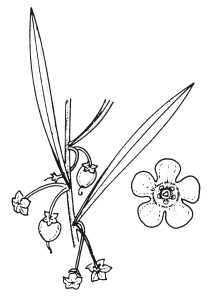Family:
Myoporaceae
Eremophila deserti
Turkeybush
(syn. Myoporum deserti)
Other Names: Ellangowan poison-bush, Dogwood
First Nations Name(s):

Regional Subspecies:
Occurrence:
Regional:
Murrumbidgee catchment, along creeks and rivers.
Australia:
Qld, NSW, Vic, SA, WA.
Habitat:
A wide variety of communities on calcareous red earths to stony skeletal soils on hillsides and riversides.
Habit:
Erect, much-branched hairless shrub 1-4 m high, with warty branchlets.
Characteristics:
Has been reported to poison stock.
Flowering:
White, late winter to early summer. Bell-shaped.
Seed Collection:
Collect when fruit are yellow.
Propagation:
From cuttings or fresh seed sown late summer-autumn. Remove flesh of fruit and soak overnight in warm water. Sow 2-3 mm deep and cover with fine gravel.
VALUES:
Land Protection:
Stabilises soil on riverbanks.
Wildlife:
Habitat. Fruits eaten by plains turkeys, emus, honeyeaters and silvereyes.
Ornamental:
Attractive ornamental for garden windbreaks, parks, screens or informal hedges. Prune lightly and regularly to promote bushiness.
